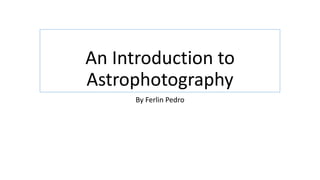
Introduction to astronomy telescopes-astrophotography
- 1. An Introduction to Astrophotography By Ferlin Pedro
- 2. Key Astronomical Concepts • The Celestial Sphere • Altitude/Azimuth Coordinates • Light Spectrum
- 4. Alt/Az Coordinates • Altitude is the angular distance of an object above the local horizon. It ranges from 0 degrees at the horizon to 90 degrees at the zenith, the spot directly overhead. • Azimuth is the angular distance of an object from the local North, measured along the horizon. An object which is due North has azimuth = 0 degrees; due East is azimuth = 90 degrees; due South is azimuth = 180 degrees; due West is azimuth = 270 degrees. • Source: http://spiff.rit.edu
- 5. Light Spectrum • Light is measured in nanometers (nm). • Each nanometer represents a wavelength of light or band of light energy. • Visible light is the part of the spectrum from 380nm to 780nm. • Source: http://eyelighting.com
- 6. Types of Telescopes • Two main types of telescopes are: • Refractor • Reflector
- 7. Parts of a Telescope Example using a Refractor Finder Scope Objective Lens Dew Cover Eyepiece 90 deg Mirror Diagonal Dovetail Mount Bar Focuser Image credit: Explore Scientific USA
- 8. How does a refractor work? Image credit: Liverpool Astronomical Society • Typical refractors have two lenses: a concave and a convex lens. • The concave lens focuses the light given off by an object into one focus point (focal point). • The convex lens spreads out the light from the concave lens to ‘focus’ light from a faraway object.
- 9. Key facts about Refractor Telescopes • Uses lenses to produce an image. • Inexpensive for small apertures; great for beginners. But gets expensive as aperture increases; mainly for enthusiast. • Refractors have an inherent problem of image distortion and chromatic aberration (colored fringes). • Expensive refractors (apochromatic) ‘corrects’ distortion and chromatic aberration using specialized lenses. • The famous Italian astronomer, Galileo Galilei, used a refractor that was just under 2 inches long, magnifying at 30x.
- 10. Types of Telescopes (continued) • Reflector (aka Newtonian Reflector) Image credit: Explore Scientific USA
- 11. Key facts about Reflecting Telescopes • Uses a combination of mirrors to gather and focus light – Primary and Secondary. • The amount of light gathering power is favourable since reflectors are generally inexpensive for larger aperture sizes. • Produces clearer images and no false colours. • Best for observing large objects (e.g. Jupiter and Saturn) and faint objects, such as galaxies and nebulae. • An inherent flaw is ‘coma’, where stars in the field of view appears ‘stretched’ due to the curvature of the primary mirror. Can be corrected with a ‘coma-corrector’ • English Physicist, Sir Isaac Newton, invented it in the 1680s.
- 12. How does a reflector work? Image credit: Liverpool Astronomical Society • No objective lens for light to enter. Instead, a concave mirror at the opposite end focuses an image of a faraway object. • A small flat mirror redirects the image to the side of the telescope where the eyepiece is located. • Light directly passes to the eyepiece, which then forms an enlarged image.
- 13. Simple Astrophotography Gear • An inexpensive telescope with aperture ranging from 2”- 6”. • A webcam or smartphone camera with 5-8 megapixals or better. • Mounting accessories for webcam or smartphone to eyepiece. • A sturdy tripod.
- 15. Example #1: Explore Scientific 90mm Refractor • Telescope: 90mm Refractor including Tripod - US$85 • Gosky Universal Smartphone adapter – US$19
- 16. Budget Astrophotography • Telescope aperture ranging from 3”- 8”. • DSLR Camera with T/Adapter • Sky Tracking Mount (Computerized or same as ‘Goto’) • For DSO photography, an autoguider may be essential; guidescope • Cost depends on components chosen, such as optional accessories for imaging, better mounts, better telescope, type of photography desired (DSO or planetary), etc. • Software for image capturing and processing often used. Example, BackyardEOS and Photoshop.
- 17. Example of a Budget Astrophotography Setup Image credit: astrophotography-tonight.com
- 18. Advanced Astrophotography • Mainly for the enthusiast • Professional equipment may include ‘correctors’ for inherent optical problems (coma, chromatic aberration, flat-field). • High-end DSLR CMOS (complementary metal-oxide-semiconductor) cameras or CCD cameras (Charge-coupled device). • Could be planetary or fainter DSOs. • Larger apertures and longer focal lengths (e.g. 14” f/8 or greater). • Autoguider will be necessary for DSO photography. • Broadband vs narrowband imaging.
- 19. Example of an advanced setup Image credit: astroanarchy.blogspot.com
- 20. Broadband vs Narrowband Imaging • Broadband uses the three primary colours (RGB) combined. • Narrowband focuses on specific bands of the light spectrum using specialized filters (Ha-Hydrogen-Alpha, OIII-Oxygen II, Sii-Sulphur II) • Narrowband follows the classic ‘Hubble Palette’.
- 22. Constraints to Astroimaging • Light Pollution (Can use filters or Narrowband imaging) • Weather conditions • Atmospheric conditions • Wind • Dew control (Dew prevention using dew caps, heating straps) • Other factors: available funds, learning curve, time and effort, time, and more time.
- 23. Stacking and Processing • Combining images to reduce noise and other unwanted image artifacts. • Improves signal-to-noise, resulting in better image quality and detail. • Reduces exposure time in the field. • DSO – Photoshop, Nebulosity, Pixinsight, MaximDL • Planetary – Autostakkert, Registax, Photoshop for processing.
- 24. DSO Stacking
- 26. • THE END
